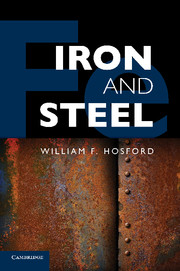Book contents
- Frontmatter
- Contents
- Preface
- 1 General Introduction
- 2 Early History of Iron and Steel
- 3 Modern Steel Making
- 4 Constitution of Carbon Steels
- 5 Plastic Strength
- 6 Annealing
- 7 Deformation Mechanisms and Crystallographic Textures
- 8 Substitutional Solid Solutions
- 9 Interstitial Solid Solutions
- 10 Diffusion
- 11 Strain Aging
- 12 Austenite Transformation
- 13 Hardenability
- 14 Tempering and Surface Hardening
- 15 Low-Carbon Sheet Steel
- 16 Sheet Steel Formability
- 17 Alloy Steels
- 18 Other Steels
- 19 Stainless Steels
- 20 Fracture
- 21 Cast Irons
- 22 Magnetic Behavior of Iron
- 23 Corrosion
- Appendix I Physical Properties of Pure Iron
- Appendix II Approximate Hardness Conversions and Tensile Strengths of Steels
- Index
- References
15 - Low-Carbon Sheet Steel
Published online by Cambridge University Press: 05 May 2012
- Frontmatter
- Contents
- Preface
- 1 General Introduction
- 2 Early History of Iron and Steel
- 3 Modern Steel Making
- 4 Constitution of Carbon Steels
- 5 Plastic Strength
- 6 Annealing
- 7 Deformation Mechanisms and Crystallographic Textures
- 8 Substitutional Solid Solutions
- 9 Interstitial Solid Solutions
- 10 Diffusion
- 11 Strain Aging
- 12 Austenite Transformation
- 13 Hardenability
- 14 Tempering and Surface Hardening
- 15 Low-Carbon Sheet Steel
- 16 Sheet Steel Formability
- 17 Alloy Steels
- 18 Other Steels
- 19 Stainless Steels
- 20 Fracture
- 21 Cast Irons
- 22 Magnetic Behavior of Iron
- 23 Corrosion
- Appendix I Physical Properties of Pure Iron
- Appendix II Approximate Hardness Conversions and Tensile Strengths of Steels
- Index
- References
Summary
Sheet Steels
Low-carbon sheet steel may be finished by hot rolling or cold rolling. Hot-rolled steel has a rougher surface finish that limits its use to applications in which surface appearance is not important (e.g., auto underbodies and firewalls). Cold-rolled steels are almost always recrystallized before sale to fabricators. They are therefore softer than hot-rolled steels and have a much better surface finish.
Usually aluminum is added to molten low-carbon steel as it is poured. Without the addition of aluminum, dissolved oxygen would react with dissolved carbon to from CO. This reaction is violent, the CO bubbles causing steel droplets to fly into the air where they ignite. This process is called killing the steel and the steel called killing. AKDQ (aluminum-killed, drawing quality) is the designation for most of the steel sheet used in forming operations. The amount of oxygen that can dissolve in molten steel decreases with increasing carbon contents, as shown in Figure 15.1. Therefore, killing is not required for higher carbon contents. Today almost all low-carbon steel is continuously cast. AKDQ sheets usually contain 0.03% C or less.
- Type
- Chapter
- Information
- Iron and Steel , pp. 167 - 178Publisher: Cambridge University PressPrint publication year: 2012



